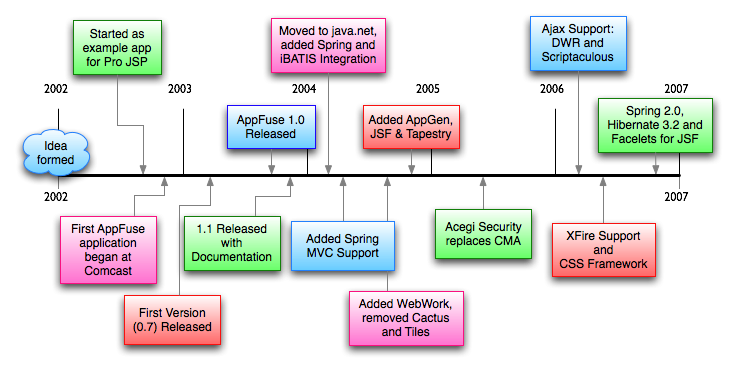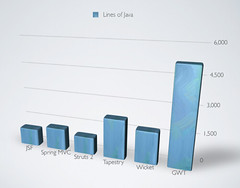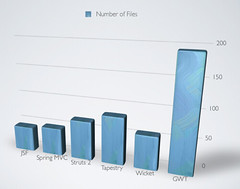When describing my bias against JSF back in November, I wrote:
... there's a lot of folks praising JSF 2 (and PrimeFaces moreso). That's why I'll be integrating it (or merging your pull request) into the 2.3 release of AppFuse. Since PrimeFaces contains a Bootstrap theme, I hope this is a pleasant experience and my overall opinion of JSF improves.
Shortly after the AppFuse 2.2.1 release in December, Gilberto Andrade contributed a sample project that used Mojarra (the JSF RI) and PrimeFaces instead of MyFaces and its Tomahawk components. Last week, I spent a few hours integrating Gilberto's changes into AppFuse's master branch. You can see all the changes I made (which include a Jetty plugin upgrade and some cleanup) in this Crucible review. Feel free to leave comments on ask questions in the review itself.
The first thing I noticed when integrating PrimeFaces is you have to add a custom repository in order to get its artifacts via Maven.
<repositories>
<repository>
<id>prime-repo</id>
<name>Prime Repo</name>
<url>http://repository.primefaces.org</url>
</repository>
</repositories>
This is unfortunate since all of AppFuse's other dependencies can be found in Maven Central. It means that if you're using a JSF archetype, the PrimeFaces repo will be checked for artifacts first, causing an unnecessary slowdown in artifact resolution. I hope the PrimeFaces developers fix this soon.
While integrating these two frameworks, I ran into a number of issues.
An IllegalStateException on startup when using "mvn jetty:run"
The first issue I encountered was that I was unable to run the app in Jetty. It worked fine in Tomcat but I got the following error in Jetty:
2013-01-31 22:28:07.683:WARN:/:unavailable
java.lang.IllegalStateException: Application was not properly initialized at startup, could not find Factory: javax.faces.context.FacesContextFactory
at javax.faces.FactoryFinder$FactoryManager.getFactory(FactoryFinder.java:951)
at javax.faces.FactoryFinder.getFactory(FactoryFinder.java:316)
at javax.faces.webapp.FacesServlet.init(FacesServlet.java:302)
at org.eclipse.jetty.servlet.ServletHolder.initServlet(ServletHolder.java:492)
at org.eclipse.jetty.servlet.ServletHolder.doStart(ServletHolder.java:312)
I found the fix for this on Stack Overflow and added the following listener to my web.xml to solve it.
<listener>
<listener-class>com.sun.faces.config.ConfigureListener</listener-class>
</listener>
Conditionally rendering a button disables its click-ability
The next thing I noticed was the Delete button didn't work when editing a user. It was hidden correctly when adding a user, but clicking on it to delete a user simply refreshes the page. Below is the code I used successfully with MyFaces. For some reason, this doesn't work with PrimeFaces.
<c:if test="${not empty userForm.user.id}">
<h:commandButton value="#{text['button.delete']}" action="#{userForm.delete}"
styleClass="btn" onclick="return confirmMessage(msgDelConfirm)"/>
</c:if>
I also tried the following, but no dice. This is currently an open issue.
<h:commandButton rendered="${not empty userForm.user.id}" value="#{text['button.delete']}"
action="#{userForm.delete}" styleClass="btn" onclick="return confirmMessage(msgDelConfirm)"/>
The PrimeFaces Bootstrap theme 404s on some images
After integrating PrimeFaces' Bootstrap theme, the following error shows up in server logs.
[INFO] [talledLocalContainer] Feb 02, 2013 10:40:25 PM com.sun.faces.application.resource.ResourceHandlerImpl logMissingResource
[WARNING] [talledLocalContainer] WARNING: JSF1064: Unable to find or serve resource, images/ui-bg_highlight-hard_70_000000_1x100.png, from library, primefaces-bootstrap.
This seems to have happened before in previous releases and is currently an open issue.
Canoo WebTest doesn't work with fileUpload nor to set checkbox values
We use Canoo WebTest to run integration tests on the UI in AppFuse. For some reason, performing file uploads and setting checkbox values works fine with MyFaces/Tomahawk, but not with Mojarra/PrimeFaces. I'm not sure if this is caused by the JSF core or the component library, but it remains an open issue. For now, I've just commented out the parts of tests that used to do this.
On a related note, getting the real path of a resource from the ServletContext worked fine before the switch, but results in a null value now.
String uploadDir = getServletContext().getRealPath("/resources") + "/" + request.getRemoteUser() + "/";
PrimeFaces resources served up at /javax.faces.resource/* not found
While I didn't have problems with this in AppFuse, I did encounter it in AppFuse Light. I don't know why there was a difference between the two, but it turned out to be caused by the UrlRewriteFilter and my desire for extensionless URLs. The outbound-rule to strip .xhtml from URLs was the culprit. Adding a condition to it solved the problem. Yeah, the condition seems backwards, but it works.
<outbound-rule match-type="regex">
<condition type="query-string" operator="equal">ln=primefaces</condition>
<from>^(.*)\.xhtml(\?.*)?$</from>
<to last="false">$1$2</to>
</outbound-rule>
Summary
The initial switch to Mojarra/PrimeFaces was pretty easy thanks to Gilberto's sample project. However, the small issues encountered after that turned out to be quite frustrating and you can see that several are still not fixed. I guess it just goes to show that not all web frameworks are perfect. Hopefully we'll get these minor issues fixed before the next release. In the meantime, you can checkout the updated demos for AppFuse JSF and AppFuse Light JSF.









